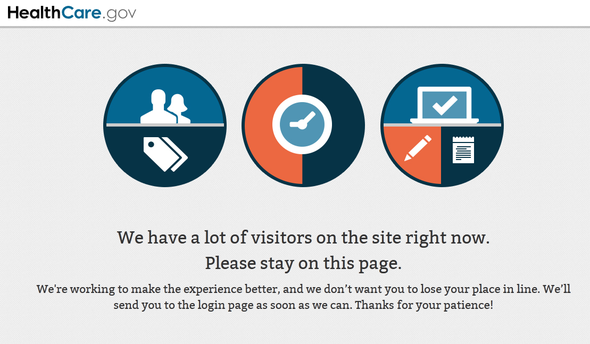Obamacare Insurance Exchange Websites: Tech CritiqueObamacare Insurance Exchange Websites: Tech Critique
State and federal websites' failure to work as advertised in first days of insurance availability can be blamed on software bottlenecks due to poor design.


Healthcare Robotics: Patently Incredible Inventions
Healthcare Robotics: Patently Incredible Inventions(click image for larger view)
This is what happens when government decides it can provide an online shopping experience to rival Expedia. The online insurance exchanges mandated by the Affordable Care Act choked on a surge of traffic when they launched Tuesday to begin signing up consumers for policies that will take effect in January.
The widespread problems affected both the states that had set up their own online insurance websites and the federal government's Healthcare.gov site, which was available to the citizens of 36 other states. Although there had been advance warning of functional glitches and features that would not be ready for the initial launch, the sites largely failed at a much more basic level: They were incapable of fully meeting the demand from the public. The citizens flocking to the site because they are currently uninsured or paying too much for health insurance encountered websites that were slow, unresponsive, or just unreachable.
On its second day of operation, the Healthcare.gov site was still having problems. The website itself was available as a marketing website, just not consistently available as an application. At the first stage of the process, where users create an account and share the information necessary to match them with the plans they are eligible for, the signup form was only intermittently available. The most visible change from launch day to day two was a prettying up of the error message page, a sort of equivalent of the infamous Twitter "fail whale" shown when twitter.com is too busy -- saying, "We have a lot of visitors on the site right now. Please stay on this page. We're working to make the experience better, and we don't want you to lose your place in line. We'll send you to the login page as soon as we can. Thanks for your patience!"
On the plus side, boosters of the law and backers of President Obama tried to shrug off the poor Web experience as evidence of how much overwhelming demand there was from citizens for better access to affordable health insurance. As a general principle, Web software architects sometimes argue that it can be impossible to model how consumers will interact with a website until it's actually available to the public. So when the public relations folks for the exchanges complain of unexpectedly high traffic, should we cut them a little slack?
"The excuse that the load was unexpected -- in my opinion, that's not a good excuse," said Jyoti Bansal, founder and CEO of AppDynamics, an application performance management firm that counts Netflix among its customers. "They should have known better about that."
Planning and testing for a big website launch like this is certainly challenging, but it's not impossible, Bansal said. The right way to plan to have enough website capacity is to take your expected demand and at least double it, then create a series of test scripts that simulate that load, he said.

Obamacare please wait
Healthcare.gov was still overloaded on day two.
Bansal suspects the real problem is that even though Obamacare proponents talked about wanting to provide a slick online consumer shopping experience, the government technologists (and even the consulting firms they hired) had too little experience with what that really means. Most federal and state organizations run largely informational websites or applications that serve a relatively small population of employees and contractors, he said. "Very few government organizations would have these sorts of very large scale, public, interactive, transactional Web apps -- it's a newer thing for them." The behavior of the Healthcare.gov site suggests that it was probably the registration software component that stalled or failed under high load, Bansal said. "Most of the bottlenecks in a system like this are in software, not hardware." Now that the bottlenecks are glaringly obvious the site architects will be able to address them in the coming weeks and months, he predicted.
"This is a crisis-driven, death march project," said Bill Curtis, chief scientist at Cast, a software quality analysis firm, and the director of the Consortium for IT Software Quality.
"A lot of it is probably a badly designed law, which is like badly designed software," Curtis said. That's not a political statement -- he's in favor of people getting access to health insurance -- but the complexities of the law also make for complex software logic, making it harder to deliver a working system.
"In many cases, these kinds of problems start before IT gets the call to start building the system," Curtis said. "I think you can see that from the way this seems to be almost universal across the states. It's a pretty consistent problem across all people trying to implement state or national exchanges."
Adding to the complexity, the insurance exchanges are not standalone but also need to connect to other state, federal, and insurance company systems, Curtis said. "If you barely had time to get your system up, you probably didn't have time to test the interfaces, and most IT people will tell you the biggest problems crop up with layers of systems and interactions between different systems."
Although the delays are embarrassing, they are hardly fatal. Plans purchased through these exchanges will not go into effect until January, and consumers who sign up before Dec. 15 should be able to have coverage start with the new year. Open enrollment will continue until March, after which uninsured citizens who have failed to take advantage of the program will face potential tax penalties. And although the websites are a major component of the program, they are not the only way to sign up for coverage.
The effect of the "individual mandate," combined with improved availability of affordable coverage, is supposed to spread the risk of insurance across the young and healthy as well as the old and infirm.
Follow David F. Carr on Twitter @davidfcarr or Google+. His book Social Collaboration For Dummies is scheduled for release in October 2013.
About the Author
You May Also Like






